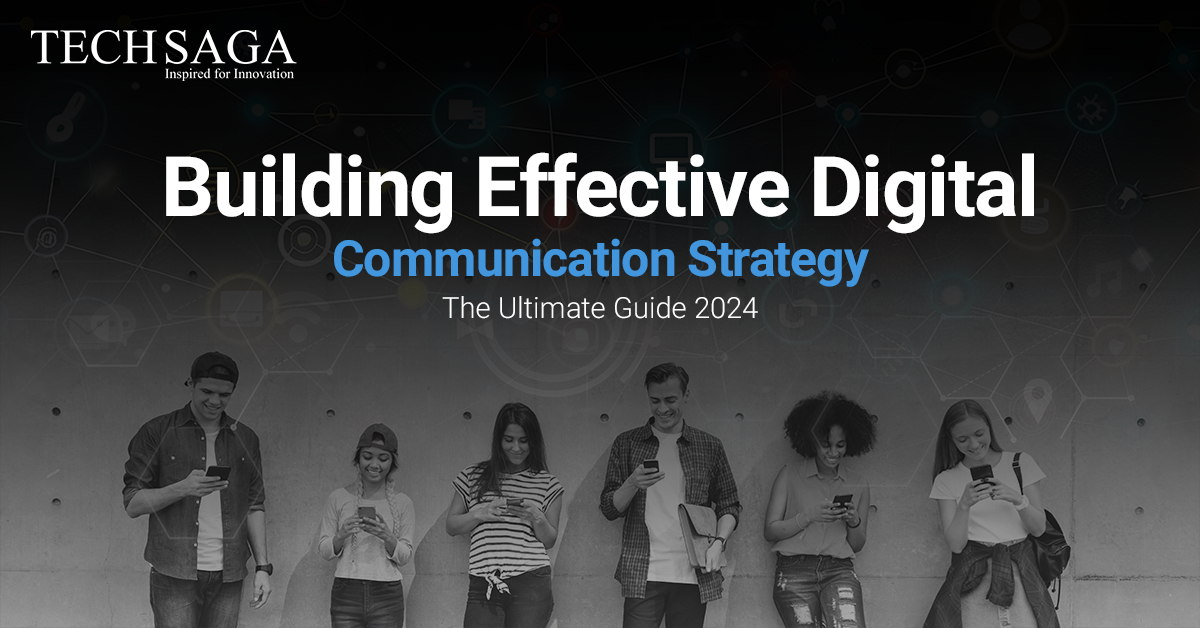Team Techsaga
Gain valuable insights and stay updated with the latest innovations through our engaging blog. Explore trends, technology advancements, and expert opinions to navigate the ever-evolving world of IT.
Building Effective Digital Communication Strategy: The Ultimate Guide 2024
The scenario of business communication has transformed dramatically over recent decades, driven by technological advancements. Companies have moved from traditional methods like memos and phone calls to instantaneous messages and video conferences. This shift has revolutionized how businesses connect, share information, and collaborate, breaking down geographical barriers and encouraging global partnerships.
Digital platforms streamline operations and open new avenues for customer engagement and marketing. However, this rapid evolution brings challenges, making it essential for businesses to develop robust digital marketing communication strategies. So, mastering digital communication is key to staying competitive and effective.
Understanding the Digital Communication:
Digital marketing encompasses a wide range of tools and techniques to convey messages through digital channels. This includes emails, social media, instant messaging, video conferencing, and more. The essence of digital communication lies in its ability to reach a global audience instantaneously, making it an invaluable asset in the modern world.
The Importance of Solid Strategy:
Crafting a successful digital communication strategy is essential for anyone looking to make an impact online. Whether you are a business trying to reach potential customers or non-profit aiming to raise awareness, or an individual building a personal brand, a well-thought-out- strategy can significantly enhance your digital presence and effectiveness.
Effective Communication Strategies:
Guide to Effective digital communication strategies include:-
Step-1. Understand Your Objectives-
The foundation of any communication strategy is understanding what you want to achieve. Your objectives will guide all your communication efforts, from the messages you craft to the channels you choose. So, start by clearly defining your goals:
- Identify Key Goals: Are you aiming to increase brand awareness, boost sales, improve employee engagement, or enhance public relations? Clearly articulate what you want to accomplish.
- Align with Organizational Mission: Maintain consistency and coherence in your messaging by ensuring your communication objectives are in line with your broader organizational goals and mission.
Step-2. Analyze Your Audience-
A successful communication strategy relies on a comprehensive comprehension of your intended audience. Knowing who they are, what they care about, and how they prefer to receive information is vital for crafting effective messages. To understand your audience, follow these steps:
- Segment Your Audience: Break down your audience into segments based on demographics, interests, behaviors, or other relevant criteria. Consequently, this will help tailor your messages more precisely.
- Conduct Research: Use surveys, interviews, and market research to gather insights about your audience’s preferences, needs, and pain points.
- Create Audience Personas: Develop detailed profiles of your ideal audience segments. Also, these personas should include information about their motivations, challenges, and preferred communication channels.
Step-3. Choose the Right Channels-

As there are a variety of digital channels, selecting the appropriate channels is crucial for reaching your audience effectively. Different channels are suited to different types of messages and audience segments.
- Assess Channel Options: Consider traditional channels (e.g., print media, TV) and digital channels (e.g., social media, email, websites). There are certain advantages and disadvantages to each channel.
- Match Channels to Audience Preferences: Use the channels preferred by your audience segments. For instance, younger audiences may prefer social media, while older audiences might engage more with email or print media.
- Integrate Channels: An integrated approach ensures your message is consistent across all platforms. So, create a multi-channel plan to increase interaction and reach.
Step-4. Develop Key Messages-
Once you understand your objectives, and audience and choose the right platform, it’s time to develop engaging messages that will resonate with them. Also, key messages are the core ideas you want to communicate and should be clear, concise, and compelling.
- Craft Clear Messages: Ensure your messages are crisp and clear to understand. Avoid jargon or overly complex language.
- Focus on Benefits: Highlight the benefits of your product, service, or initiative. How will it solve your audience’s problems or enhance their lives?
- Be Consistent: Make sure your messaging is consistent throughout all of your channels of communication. Moreover, consistent messages build trust and reinforce your brand identity.
Step-5. Utilizing SEO Best Practices-
Making sure your intended audience can find your content depends on search engine optimization or SEO. Therefore, implementing SEO best practices can significantly boost your online visibility and organic traffic. Key SEO strategies include:
- Keyword Research: Identify relevant keywords that your audience is searching for and incorporate them naturally into your content.
- On-Page SEO: Optimize individual pages with keywords in titles, headings, meta descriptions, and content, ensuring your website is mobile-friendly and has a fast loading speed.
- Quality Content: Create high-quality, valuable content that answers your audience’s questions and meets their needs. Long-form content and comprehensive guides often perform well in search rankings.
- Backlinks: Build backlinks from reputable websites to increase your site’s authority. Guest blogging, partnerships, and producing shareable content can help in acquiring backlinks.
- Technical SEO: Make that all technical elements of your website, including the URL hierarchy, site structure, and XML sitemaps, are search engine optimized.
Step-6. Create a Content Plan-

A well-organized content plan will help you deliver your messages effectively and on schedule. Your content plan should outline what content will be produced, when, and by whom.
- Content Calendar: Develop a calendar that schedules content production and distribution. This helps ensure timely and consistent communication.
- Content Types: Determine the types of content you’ll use, such as blog posts, videos, infographics, or social media updates. Choose formats that best convey your key messages.
- Editorial Guidelines: Establish guidelines for content creation, including tone, style, and branding. This ensures uniformity and professionalism in your communications.
Step-7. Implement and Monitor-
With your strategy and plan in place, it’s time to put everything into action. To make sure your strategy is operating as planned, effective implementation and monitoring are essential.
- Execution: Implement your communication plan according to the schedule. Make sure that everyone in the team is aware of their duties.
- Monitor Performance: Track the performance of your communication efforts using metrics and analytics. Measure factors such as engagement, reach, and conversion rates.
- Adjust as Needed: Based on your monitoring results, make adjustments to improve the effectiveness of your strategy. Moreover, flexibility allows you to respond to changes in audience behavior or market conditions.
Step-8. Evaluate and Refine-
Regular evaluation and refinement are essential for maintaining the effectiveness of your communication strategy. Therefore, conduct periodic reviews to assess how well your strategy is meeting your objectives.
- Gather Feedback: Collect feedback from your audience, stakeholders, and team members. This can provide valuable insights into the effectiveness of your communication efforts.
- Analyze Results: Review performance metrics and compare them to your objectives. Identify areas of success and areas needing improvement.
- Refine Strategy: Based on your evaluation, refine your strategy to address any issues or capitalize on new opportunities. So, continuous improvement ensures your communication remains relevant and impactful.
Step-9. Engage Your Team-
Effective communication strategies involve not just external messaging but also internal alignment. Engaging your team ensures everyone is on the same page and working towards common goals.
- Communicate Internally: Keep your team informed about the communication strategy and its goals. Regular updates help maintain alignment and motivation.
- Encourage Collaboration: Foster a collaborative environment where team members can share ideas and provide feedback. This enhances the overall effectiveness of your strategy.
- Provide Training: Equip your team with the skills and knowledge needed to implement the strategy effectively. Training ensures consistent messaging and professional communication.
Step-10. Leverage Technology-
Incorporating technology into your communication strategy can enhance its effectiveness and efficiency. Technology tools can streamline processes, improve reach, and provide valuable insights.
- Use Communication Tools: Utilize tools such as project management software, social media platforms, and analytics tools to support your communication efforts.
- Automate Where Possible: Implement automation for tasks such as scheduling social media posts or sending email newsletters. Therefore, this saves time and ensures timely communication.
- Analyze Data: Leverage analytics to gain insights into audience behavior and campaign performance. Data-driven decisions help refine your strategy and improve outcomes.
Finalizing:
So, creating a strong communication strategy involves clear planning and ongoing updates. Know your goals and audience, choose the right channels, and keep evaluating and engaging with your team. These steps will help you effectively share your message and achieve your goals.
TechSaga Corporations specializes in creating top-notch digital communication strategies to help businesses grow their online presence. By leveraging effective digital tools and techniques, TechSaga assists companies in transforming into recognizable brands, enhancing their online visibility, and achieving their marketing goals with precision and impact.
TAG: Content Marketing and Management, Digital Marketing, Digital Marketing Automations




